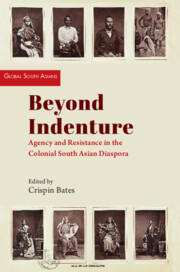Book contents
- Frontmatter
- Dedication
- Contents
- List of Figures and Tables
- Acknowledgements
- Introduction
- I Agency and Resistance
- 1 Negotiating Power in Colonial Natal: Indentured Migrants in Natal, 1860–1911
- 2 Stewed Plums, Baked Porridge and Flavoured Tea: Poisoning by Indian Domestic Servants in Colonial Natal
- 3 Labour Resistance in Indenture Plantations in the Assam Valley
- 4 A Forgotten Narrative of the Satyagraha Campaign: The Treatment of Prisoners between 1907 and 1914
- 5 Toilers across the Seas: Racial Discrimination and Political Assertion among Sikhs in Canada
- II Remigration
- 6 The Remigration of Hindostanis from Surinam to India, 1878–1921
- 7 Not So Anchored: The Remigration of Indians within the Caribbean Region
- 8 On the Move: Remigration in the Indian Ocean, 1850–1906
- III Gender and Family
- 9 Intimate Lives on Rubber Plantations: The Textures of Indian Coolie Relations in British Malaya
- 10 Labouring under the Law: Exploring the Agency of Indian Women under Indenture in Colonial Natal, 1860–1911
- 11 Gujarati ‘Passenger Indians’ in the Eastern Cape since 1900: Business, Mobility, Caste and Community
- 12 The Eurasian Female Workforce and Imperial Britain: Harnessing Domestic Labour by People of Mixed Racial Descent
- IV Legacies
- 13 After the Long March: Colonial-Era ‘Relief’ for Burma Indian Evacuees in Visakhapatnam District, 1942–1948
- 14 Opposing the Group Areas Act and Resisting Forced Displacement in Durban, South Africa
- 15 Indo-Fijians: From Agency to Abjection
- 16 New and Old Diasporas of South South Asia: Sri Lanka and Cyber-Nationalism in Malaysia
- About the Contributors
- Index
8 - On the Move: Remigration in the Indian Ocean, 1850–1906
Published online by Cambridge University Press: 31 December 2023
- Frontmatter
- Dedication
- Contents
- List of Figures and Tables
- Acknowledgements
- Introduction
- I Agency and Resistance
- 1 Negotiating Power in Colonial Natal: Indentured Migrants in Natal, 1860–1911
- 2 Stewed Plums, Baked Porridge and Flavoured Tea: Poisoning by Indian Domestic Servants in Colonial Natal
- 3 Labour Resistance in Indenture Plantations in the Assam Valley
- 4 A Forgotten Narrative of the Satyagraha Campaign: The Treatment of Prisoners between 1907 and 1914
- 5 Toilers across the Seas: Racial Discrimination and Political Assertion among Sikhs in Canada
- II Remigration
- 6 The Remigration of Hindostanis from Surinam to India, 1878–1921
- 7 Not So Anchored: The Remigration of Indians within the Caribbean Region
- 8 On the Move: Remigration in the Indian Ocean, 1850–1906
- III Gender and Family
- 9 Intimate Lives on Rubber Plantations: The Textures of Indian Coolie Relations in British Malaya
- 10 Labouring under the Law: Exploring the Agency of Indian Women under Indenture in Colonial Natal, 1860–1911
- 11 Gujarati ‘Passenger Indians’ in the Eastern Cape since 1900: Business, Mobility, Caste and Community
- 12 The Eurasian Female Workforce and Imperial Britain: Harnessing Domestic Labour by People of Mixed Racial Descent
- IV Legacies
- 13 After the Long March: Colonial-Era ‘Relief’ for Burma Indian Evacuees in Visakhapatnam District, 1942–1948
- 14 Opposing the Group Areas Act and Resisting Forced Displacement in Durban, South Africa
- 15 Indo-Fijians: From Agency to Abjection
- 16 New and Old Diasporas of South South Asia: Sri Lanka and Cyber-Nationalism in Malaysia
- About the Contributors
- Index
Summary
On 21 September 1909, the acting protector of immigrants in Mauritius wrote to the Inspector General of Police of the colony the following about Boodhun, who was now living in Seychelles:
I am informed by the bearer of the letter that an old immigrant named Boodhun who had left the colony [Mauritius] for Seychelles has returned & was on board the French Mail and that is considered as an undesirable & prevented from landing. It is to my knowledge that his son is a labourer in the service of the Beau Bassin & Rose Hill Board [in Mauritius] & he has asked me to interfere to get his father’s [repeal] … as he is willing to receive & to maintain him at his expense. In these circumstances, I hope you will issue orders accordingly.
The aforementioned story is an illustration of remigration – that is, mobility – between supposedly minor colonies without returning to India. Boodhun, an indentured worker from India, had completed his contract of five years, had probably spent many more years in Mauritius and had eventually become an ‘old immigrant’. Time and familiarity in Mauritius had shaped his information networks in such a way that he was aware of the populations in neighbouring colonies such as Seychelles. Colonial discourse emphasises how he was ‘undesirable’ in Mauritius, thus possibly rendering Seychelles a refuge for all unwanted immigrants. However, this could not be further from the truth since Seychelles had a significant population of 22,409 persons in 1909 and was a major exporter of vanilla and coconut oil.
The presence of Boodhun in Seychelles is not to reify the exotic undertones of islands as spaces of violence, disease or penalisation. Rather, his presence suggests the economic possibilities that remigrants pursued, despite the constraints of colonial administrations (here, those of Seychelles and Mauritius). This chapter uses passenger logs and colonial reports to examine Indian labour remigration within various nodes of the Indian Ocean between 1847 and 1906. Remigration, as pointed out earlier, refers to the process whereby labour migrants moved across colonies (and their dependencies) without returning to India or making the three main ports of embarkation (Calcutta, Madras and Bombay [present-day Kolkata, Chennai and Mumbai, respectively]) the points of departure. The chapter further queries the profiles of those who pursued remigration and their motivations.
- Type
- Chapter
- Information
- Beyond IndentureAgency and Resistance in the Colonial South Asian Diaspora, pp. 167 - 198Publisher: Cambridge University PressPrint publication year: 2024



